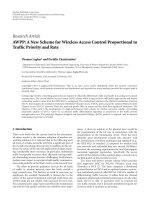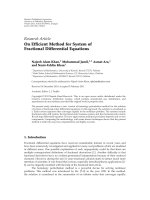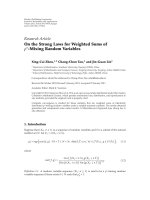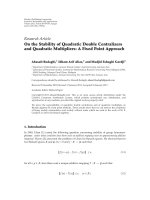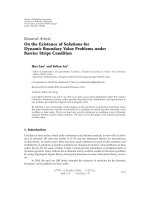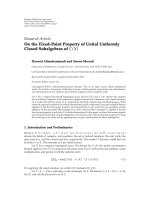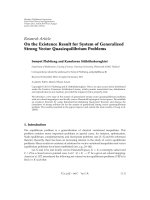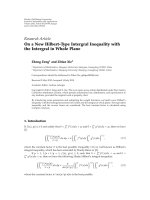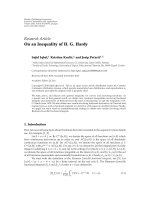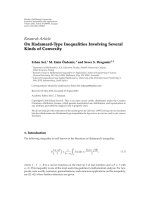Báo cáo hóa học: " Research Article On a New Hilbert-Type Intergral Inequality with the Intergral in Whole Plane" pdf
Bạn đang xem bản rút gọn của tài liệu. Xem và tải ngay bản đầy đủ của tài liệu tại đây (479.6 KB, 8 trang )
Hindawi Publishing Corporation
Journal of Inequalities and Applications
Volume 2010, Article ID 256796, 8 pages
doi:10.1155/2010/256796
Research Article
On a New Hilbert-Type Intergral Inequality with
the Intergral in Whole Plane
Zheng Zeng
1
and Zitian Xie
2
1
Department of Mathematics, Shaoguan University, Shaoguan, Guangdong 512005, China
2
Department of Mathematics, Zhaoqing University, Zhaoqing, Guangdong 526061, China
Correspondence should be addressed to Zitian Xie,
Received 5 May 2010; Accepted 14 July 2010
Academic Editor: Andrea Laforgia
Copyright q 2010 Z. Zeng and Z. Xie. This is an open access article distributed under the Creative
Commons Attribution License, which permits unrestricted use, distribution, and reproduction in
any medium, provided the original work is properly cited.
By introducing some parameters and estimating the weight functions, we build a new Hilbert’s
inequality with the homogeneous kernel of 0 order and the integral in whole plane. The equivalent
inequality and the reverse forms are considered. The best constant factor is calculated using
Complex Analysis.
1. Introduction
If fx, gx ≥ 0 and satisfy that 0 <
∞
0
f
2
xdx < ∞ and 0 <
∞
0
g
2
xdx < ∞, then we have
1
∞
0
f
x
g
x
x y
dx dy < π
∞
0
f
2
xdx
∞
0
g
2
xdx
1/2
,
1.1
where the constant factor π is the best possible. Inequality 1.1 is well known as Hilbert’s
integral inequality, which has been extended by Hardy-Riesz as 2.
If p>1, 1/p 1/q 1, fx, gx ≥ 0, such that 0 <
∞
0
f
p
xdx < ∞ and 0 <
∞
0
g
q
xdx < ∞, then we have the following Hardy-Hilbert’s integral inequality:
∞
0
f
x
g
y
x y
dx dy <
π
sin
π/p
∞
0
f
p
xdx
1/p
∞
0
g
q
xdx
1/q
,
1.2
where the constant factor π/sinπ/p also is the best possible.
2 Journal of Inequalities and Applications
Both of them are important in Mathematical Analysis and its applications 3.It
attracts some attention in recent years. Actually, inequalities 1.1 and 1.2 have many
generalizations and variations. Equation 1.1 has been strengthened by Yang and others
including double series inequalities4–21.
In 2008, Xie and Zeng gave a new Hilbert-type Inequality 4 as follows.
If a>0,b > 0,c > 0,p > 1, 1/p 1/q 1, fx,gx ≥ 0 such that 0 <
∞
0
x
−1−p/2
f
p
xdx < ∞ and 0 <
∞
0
x
−1−q/2
g
q
xdx < ∞, then
∞
0
f
x
g
y
x a
2
y
x b
2
y
x c
2
y
dx dy
<K
∞
0
x
−1−p/2
f
p
xdx
1/p
∞
0
x
−1−q/2
g
q
xdx
1/q
,
1.3
where the constant factor K π/a ba cb c is the best possible.
The main purpose of this paper is to build a new Hilbert-type inequality with
homogeneous kernel of degree 0, by estimating the weight function. The equivalent
inequality is considered.
In the following, we always suppose that: 1/p 1/q 1,p>1,r∈ −1, 0,0<α<
β<π.
2. Some Lemmas
We start by introducing some lemmas.
Lemma 2.1. If k
1
:
∞
0
u
−1r
ln1 2u cos α u
2
/1 2u cos β u
2
du, k
2
:
∞
0
u
−1r
ln1 −
2u cos β u
2
/1 − 2u cos α u
2
du, then
k
1
4π sin
r
β − α
/2
sin
r
α β
/2
r sin rπ
,
k
2
4π sin
r
β − α
/2
sin
rπ − r
α β
/2
r sin rπ
,
k :
∞
−∞
|
u
|
−1r
ln
1 2u cos α u
2
1 2u cos β u
2
du
k
1
k
2
4π sin
r
β − α
/2
cos
r/2
π −α − β
r cos
rπ/2
.
2.1
Proof. We have
A :
∞
0
x
r−1
ln
x
2
2x cos α 1
dx
1
r
x
r
ln
x
2
2x cos α 1
∞
0
−
2
r
∞
0
x
r
x cos α
x
2
2x cos α 1
dx
: −
2
r
B.
2.2
Journal of Inequalities and Applications 3
Setting fzz
r
z cos α/z
2
2z cos α 1, z
1
−e
iα
,z
2
−e
−iα
, then
B
2πi
1 − e
2πri
Res
f, z
1
Res
f, z
2
2πi
1 − e
2πri
z
r
1
z
1
cos α
z
1
− z
2
z
r
2
z
2
cos α
z
2
− z
1
−
π cos rα
sin rπ
2.3
we find that A −2B/r 2π cos rα/r sin rπ, then
k
1
:
∞
0
u
−1r
ln
1 2u cos α u
2
1 2u cos β u
2
du
4π sin
r
β − α
/2
sin
r
α β
/2
r sin rπ
,
k
2
:
∞
0
u
−1r
ln
1 − 2u cos β u
2
1 − 2u cos α u
2
du
∞
0
u
−1r
ln
1 2u cos
π −β
u
2
1 2u cos
π −α
u
2
du
4π sin
r
β − α
/2
sin
r/2
2π −α − β
r sin rπ
,
k
∞
−∞
|
u
|
−1r
ln
1 2u cos α u
2
1 2u cos β u
2
du
∞
0
u
−1r
ln
1 2u cos α u
2
1 2u cos β u
2
du
0
−∞
−u
−1r
ln
1 2u cos β u
2
1 2u cos α u
2
du
k
1
k
2
4π sin
r
β − α
/2
cos
r/2
π −α − β
r cos
rπ/2
.
2.4
The lemma is proved.
Lemma 2.2. Define the weight functions as follow:
w
x
:
∞
−∞
|
x
|
−r
y
1−r
ln
x
2
2xy cos α y
2
x
2
2xy cos β y
2
dy,
w
y
:
∞
−∞
y
r
|
x
|
1r
ln
x
2
2xy cos α y
2
x
2
2xy cos β y
2
dx,
2.5
then wx wyk 4π sinrβ − α/2 cosr/2π −α − β/r cosrπ/2.
Proof. We only prove that wxk for x ∈ −∞, 0.
Using Lemma 2.1, setting y ux andy −ux,
w
x
0
−∞
−x
−r
−y
1−r
ln
x
2
2xy cos αy
2
x
2
2xy cos βy
2
dy
∞
0
−x
−r
y
1−r
ln
x
2
2xy cos βy
2
x
2
2xy cos αy
2
dy
∞
0
u
−1r
ln
1 2u cos α u
2
1 2u cos β u
2
du
∞
0
u
−1r
ln
1−2u cos βu
2
1 − 2u cos αu
2
duk
1
k
2
k.
2.6
and the lemma is proved.
4 Journal of Inequalities and Applications
Lemma 2.3. For ε>0, and r −max{2ε/p, 2ε/q} ∈ −1, 0, define both functions
f, g as follows:
f
x
⎧
⎪
⎪
⎪
⎨
⎪
⎪
⎪
⎩
x
−r−1−2ε/p
, if x ∈
1, ∞
,
0, if x ∈
−1, 1
,
−x
−r−1−2ε/p
, if x ∈
−∞, −1
,
g
x
⎧
⎪
⎪
⎪
⎨
⎪
⎪
⎪
⎩
x
r−1−2ε/q
, if x ∈
1, ∞
,
0, if x ∈
−1, 1
,
−x
r−1−2ε/q
, if x ∈
−∞, −1
,
2.7
then
I
ε
: ε
∞
−∞
|
x
|
pr1−1
f
p
xdx
1/p
∞
−∞
|
x
|
qr−1−1
g
q
xdx
1/q
1,
I
ε
: ε
∞
−∞
f
x
g
y
ln
x
2
2xy cos α y
2
x
2
2xy cos β y
2
dx dy −→ k
ε −→ 0
.
2.8
Proof. Easily, we get the following:
I
ε
ε
2
∞
1
x
−1
x
−2ε
dx
1/p
2
∞
1
x
−1
x
−2ε
dx
1/q
1.
2.9
Let y −Y ,using
f−x
fx, g−xgx and
f
−x
∞
−∞
g
y
ln
x
2
− 2xy cos α y
2
x
2
− 2xy cos β y
2
dy
f
x
∞
−∞
g
Y
ln
x
2
2xY cos α Y
2
x
2
2xY cos β Y
2
dY,
2.10
we have that
fx
∞
−∞
gy|lnx
2
2xy cos αy
2
/x
2
2xy cos βy
2
|dy is an even function
on x, then
I
ε
2ε
∞
0
f
x
∞
−∞
g
y
ln
x
2
2xy cos α y
2
x
2
2xy cos β y
2
dy
dx
2ε
∞
1
x
−r−1−2ε/p
−1
−∞
−y
r−1−2ε/q
ln
x
2
2xy cos β y
2
x
2
2xy cos α y
2
dy
dx
∞
1
x
−r−1−2ε/p
∞
1
y
r−1−2ε/q
ln
x
2
2xy cos α y
2
x
2
2xy cos β y
2
dy
dx
: I
1
I
2
.
2.11
Journal of Inequalities and Applications 5
Setting y tx then
I
1
2ε
∞
1
x
−r−1−2ε/p
∞
1
y
r−1−2ε/q
ln
x
2
− 2xy cos β y
2
x
2
− 2xy cos α y
2
dy
dx
2ε
∞
1
x
−1−2ε
∞
1/x
t
r−1−2ε/q
ln
1 − 2t cos β t
2
1 − 2t cos α t
2
dt
dx
2ε
∞
1
x
−1−2ε
∞
1
t
r−1−2ε/q
ln
1 − 2t cos β t
2
1 − 2t cos α t
2
dt
dx
∞
1
x
−1−2ε
1
1/x
t
r−1−2ε/q
ln
1 − 2t cos β t
2
1 − 2t cos α t
2
dt
dx
∞
1
t
r−1−2ε/q
ln
1 − 2t cos β t
2
1 − 2t cos α t
2
dt
2ε
1
0
t
r−1−2ε/q
ln
1 − 2t cos β t
2
1 − 2t cos α t
2
∞
1/t
x
−1−2ε
dx
dt
∞
1
t
r−1−2ε/q
ln
1 − 2t cos β t
2
1 − 2t cos α t
2
dt
1
0
t
r−12ε/p
ln
1 − 2t cos β t
2
1 − 2t cos α t
2
dt
∞
0
t
r−1−2ε/q
ln
1 − 2t cos β t
2
1 − 2t cos α t
2
dt
1
0
t
2ε/p
− t
−2ε/q
t
r−1
ln
1 − 2t cos β t
2
1 − 2t cos α t
2
dt
4π sin
r −
2ε/q
β − α
/2
sin
r −
2ε/q
2π −α − β
/2
r −
2ε/q
sin
r −
2ε/q
π
η
ε
,
2.12
where lim
ε →0
ηε0, and we have I
1
→ k
2
ε → 0
.
Similarly, I
2
→ k
1
ε → 0
. The lemma is proved.
Lemma 2.4. If fx is a nonnegative measurable function and 0 <
∞
−∞
|x|
p1r−1
f
p
xdx < ∞,then
J :
∞
−∞
y
pr−1
∞
−∞
fx
ln
x
2
2xy cos α y
2
x
2
2xy cos β y
2
dx
p
dy ≤ k
p
∞
−∞
|
x
|
p1r−1
f
p
x
dx.
2.13
Proof. By Lemma 2.2,wefindthat
∞
−∞
ln
x
2
2xy cos α y
2
x
2
2xy cos β y
2
dx
p
∞
−∞
ln
x
2
2xy cos α y
2
x
2
2xy cos β y
2
|
x
|
1r/q
y
1−r/p
fx
y
1−r/p
|
x
|
1r/q
dx
p
6 Journal of Inequalities and Applications
≤
∞
−∞
ln
x
2
2xy cos α y
2
x
2
2xy cos β y
2
|
x
|
1rp−1
y
1−r
f
p
x
dx
×
∞
−∞
ln
x
2
2xy cos α y
2
x
2
2xy cos β y
2
y
1−rq−1
|
x
|
1r
dx
p−1
k
p−1
y
−rp1
∞
−∞
ln
x
2
2xy cos α y
2
x
2
2xy cos β y
2
|
x
|
1rp−1
y
1−r
f
p
x
dx,
J ≤ k
p−1
∞
−∞
∞
−∞
ln
x
2
2xy cos α y
2
x
2
2xy cos β y
2
|
x
|
1rp−1
y
1−r
f
p
x
dx
dy
k
p−1
∞
−∞
∞
−∞
ln
x
2
2xy cos α y
2
x
2
2xy cos β y
2
|
x
|
1rp−1
y
1−r
dy
f
p
x
dx
k
p
∞
−∞
|
x
|
p1r−1
f
p
x
dx.
2.14
3. Main Results
Theorem 3.1. If both functions, fx and gx, are nonnegative measurable functions and
satisfy 0 <
∞
−∞
|x|
p1r−1
f
p
xdx < ∞ and 0 <
∞
−∞
|x|
q1−r−1
g
q
xdx < ∞,then
I
∗
:
∞
−∞
f
x
g
y
ln
x
2
2xy cos α y
2
x
2
2xy cos β y
2
dx dy
<k
∞
−∞
|
x
|
p1r−1
f
p
xdx
1/p
∞
−∞
|
x
|
q1−r−1
g
q
xdx
1/q
,
3.1
J
∞
−∞
y
pr−1
∞
−∞
f
x
ln
x
2
2xy cos α y
2
x
2
2xy cos β y
2
dx
p
dy
<k
p
∞
−∞
|
x
|
p1r−1
f
p
x
dx.
3.2
Inequalities 3.1 and 3.2 are equivalent, and where the constant factors k and k
p
are the best
possibles.
Proof. If 2.13 takes the form of equality for some y ∈ −∞, 0 ∪ 0, ∞, then there exists
constants M and N, such that they are not all zero, and
M
|
x
|
1rp−1
y
1−r
f
p
x
N
y
1−rq−1
|
x
|
1r
a.e. in
−∞, ∞
×
−∞, ∞
.
3.3
Journal of Inequalities and Applications 7
Hence, there exists a constant C, such that
M
|
x
|
1rp
f
p
x
N
y
1−rq
C a.e. in
−∞, ∞
×
−∞, ∞
.
3.4
We claim that M 0. In fact, if M
/
0, then |x|
p1r−1
f
p
xC/M|x|
−1
a.e. in −∞, ∞
which contradicts the fact that 0 <
∞
−∞
|x|
p1r−1
f
p
xdx < ∞. In the same way, we claim that
N 0. This is too a contradiction and hence by 2.13, we have 3.2.
By H
¨
older’s inequality with weight 22 and 3.2,wehavethefollowing:
I
∗
∞
−∞
y
−1r1/q
∞
−∞
f
x
ln
x
2
2xy cos α y
2
x
2
2xy cos β y
2
dx
y
1−r−1/q
g
y
dy
≤
J
1/p
∞
−∞
y
q1−r−1
g
q
ydy
1/q
.
3.5
Using 3.2, we have 3.1.
Setting gy|y|
rp−1
∞
−∞
fx|lnx
2
2xy cos α y
2
/x
2
2xy cos β y
2
|dx
p−1
,
then J
∞
−∞
|y|
q1−r−1
g
q
ydy by 2.13, we have J<∞.IfJ 0 then 3.2 is proved. If
0 <J<∞, by 3.1 ,weobtain
0 <
∞
−∞
y
q1−r−1
g
q
y
dy J I
∗
<k
∞
−∞
|
x
|
p1r−1
f
p
xdx
1/p
∞
−∞
|
x
|
q1−r−1
g
q
xdx
1/q
,
∞
−∞
|
x
|
q1−r−1
g
q
xdx
1/p
J
1/p
<k
∞
−∞
|
x
|
p1r−1
f
p
xdx
1/p
.
3.6
Inequalities 3.1 and 3.2 are equivalent.
If the constant factor k in 3.1 is not the best possible, then there exists a positive h
with h<k, such that
∞
−∞
f
x
g
y
ln
x
2
2xy cos α y
2
x
2
2xy cos β y
2
dx dy
<h
∞
−∞
|
x
|
p1r−1
f
p
xdx
1/p
∞
−∞
|
x
|
q1−r−1
g
q
xdx
1/q
.
3.7
For ε>0, by 3.7,usingLemma 2.3, we have
k o
1
<εh
∞
−∞
|
x
|
−1
f
p
xdx
1/p
∞
−∞
|
x
|
−1
g
q
xdx
1/q
k.
3.8
Hence, we find k o1 <h.For ε → 0
, it follows that k ≤ h, which contradicts the fact that
h<k. Hence the constant k in 3.1 is the best possible.
Thus we complete the proof of the theorem.
8 Journal of Inequalities and Applications
Remark 3.2. For α π/4,β π/3in3.1, we have the following particular result:
∞
−∞
f
x
g
y
ln
x
2
√
2xy y
2
x
2
xy y
2
dx dy
<
4π sin
πr/24
sin
5πr/24
r sin
πr/2
∞
−∞
|
x
|
p1r−1
f
p
xdx
1/p
∞
−∞
|
x
|
q1−r−1
g
q
xdx
1/q
.
3.9
References
1 G. H. Hardy, J. E. Littlewood, and G. P
´
olya, Inequalities, Cambridge University Press, London, UK,
1952.
2 G. H. Hardy, “Note on a theorem of Hilbert concerning series of positive terms,” Proceedings of the
London Mathematical Society, vol. 23, no. 2, pp. 45–46, 1925.
3 D. S. Mitrinovi
´
c, J. E. Pe
ˇ
cari
´
c, and A. M. Fink, Inequalities Involving Functions and Their Integrals and
Derivatives, vol. 53, Kluwer Academic, Boston, Mass, USA, 1991.
4 Z. Xie and Z. Zeng, “A Hilbert-type integral inequality whose kernel is a homogeneous form of degree
−3,” Journal of Mathematical Analysis and Applications, vol. 339, no. 1, pp. 324–331, 2008.
5 Z. Xie and Z. Zeng, “A Hilbert-type integral inequality with a non-homogeneous form and a best
constant factor,” Advances and Applications in Mathematical Science, vol. 3, no. 1, pp. 61–71, 2010.
6 Z. Xie and Z. Zeng, “The Hilbert-type integral inequality with the system kernel of -λ degree
homogeneous form,” Kyungpook Mathematical Journal, vol. 50, pp. 297–306, 2010.
7 B. Yang, “A new Hilbert-type integral inequality with some parameters,” Journal of Jilin University,
vol. 46, no. 6, pp. 1085–1090, 2008.
8 Z. Xie and B. Yang, “A new Hilbert-type integral inequality with some parameters and its reverse,”
Kyungpook Mathematical Journal, vol. 48, no. 1, pp. 93–100, 2008.
9 Z. Xie, “A new Hilbert-type inequality with the kernel of -3μ-homogeneous,” Journal of Jilin University,
vol. 45, no. 3, pp. 369–373, 2007.
10 Z Xie and J. Murong, “A reverse Hilbert-type inequality with some parameters,” Journal of Jilin
University, vol. 46, no. 4, pp. 665–669, 2008.
11 Z. Xie, “A new reverse Hilbert-type inequality with a best constant factor,” Journal of Mathematical
Analysis and Applications, vol. 343, no. 2, pp. 1154–1160, 2008.
12 B. Yang, “A Hilbert-type inequality with a mixed kernel and extensions,” Journal of Sichuan Normal
University, vol. 31, no. 3, pp. 281–284, 2008.
13 Z. Xie and Z. Zeng, “A Hilbert-type inequality with parameters,” Natural Science Journal of Xiangtan
University, vol. 29, no. 3, pp. 24–28, 2007.
14 Z. Zeng and Z. Xie, “A Hilbert’s inequality with a best constant factor,” Journal of Inequalities and
Applications, vol. 2009, Article ID 820176, 8 pages, 2009.
15 B. Yang, “A bilinear inequality with a −2-order homogeneous kernel,” Journal of Xiamen University,
vol. 45, no. 6, pp. 752–755, 2006.
16 B. Yang, “On Hilbert’s inequality with some parameters,” Acta Mathematica Sinica, vol. 49, no. 5, pp.
1121–1126, 2006.
17 I. Brneti
´
candJ.Pe
ˇ
cari
´
c, “Generalization of Hilbert’s integral inequality,” Mathematical Inequalities and
Application, vol. 7, no. 2, pp. 199–205, 2004.
18 I. Brneti
´
c, M. Krni
´
c, and J. Pe
ˇ
cari
´
c, “Multiple Hilbert and Hardy-Hilbert inequalities with non-
conjugate parameters,” Bulletin of the Australian Mathematical Society, vol. 71, no. 3, pp. 447–457, 2005.
19 Z. Xie and F. M. Zhou, “A g eneralization of a Hilbert-type inequality with the best constant factor,”
Journal of Sichuan Normal University, vol. 32, no. 5, pp. 626–629, 2009.
20 Z. Xie and X. Liu, “A new Hilbert-type integral inequality and its reverse,” Journal of Henan University,
vol. 39, no. 1, pp. 10–13, 2009.
21 Z. Xie and B. L. Fu, “A new Hilbert-type integral inequality with a best constant factor,” Journal of
Wuhan University, vol. 55, no. 6, pp. 637–640, 2009.
22 J. Kang, Applied Inequalities, Shangdong Science and Technology Press, Jinan, China, 2004.
